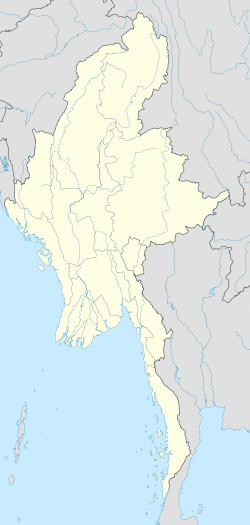Mandalay
|
Mandalay မန္တလေး |
|
|---|---|
| Cultural City | |
 |
|
| Location of Mandalay, Myanmar (Burma) | |
| Coordinates: 21°58′30″N 96°5′0″E / 21.97500°N 96.08333°ECoordinates: 21°58′30″N 96°5′0″E / 21.97500°N 96.08333°E | |
| Country |
|
| Region | Mandalay Region |
| District | Mandalay District |
| Government | |
| • Mayor | Ye Lwin |
| Area | |
| • Cultural City | 163.84 km2 (63.26 sq mi) |
| Elevation | 22 m (70 ft) |
| Population (2014 census) | |
| • Cultural City | 1,225,133 |
| • Density | 7,500/km2 (19,000/sq mi) |
| • Metro | 1,022,487 |
| • Ethnic groups | Bamars, Indian, Chinese, Shan |
| • Religions | Theravada Buddhism, Christianity, Hinduism, Islam |
| Time zone | MMT (UTC+6:30) |
| Area code(s) | 02 |
| Vehicle registration | MDY |
| Website | www |
Mandalay (/ˌmændəˈleɪ/ or /ˈmændəleɪ/; Burmese: မန္တလေး; MLCTS: manta.le: [màɴdəlé]) is the second-largest city and the last royal capital of Myanmar (Burma). Located 716 km (445 mi) north of Yangon on the east bank of the Irrawaddy River, the city has a population of 1,225,553 (2014 census).
Mandalay is the economic centre of Upper Burma and considered the centre of Burmese culture. A continuing influx of Chinese immigrants, mostly from Yunnan, in the past twenty years, has reshaped the city's ethnic makeup and increased commerce with China. Despite Naypyidaw's recent rise, Mandalay remains Upper Burma's main commercial, educational and health center.
The city gets its name from the nearby Mandalay Hill. The name is probably a derivative of a Pali word, although the exact word of origin remains unclear. The root word has been speculated to be mandala, referring to circular plains or Mandara, a mountain from Hindu mythology.
...
Wikipedia

